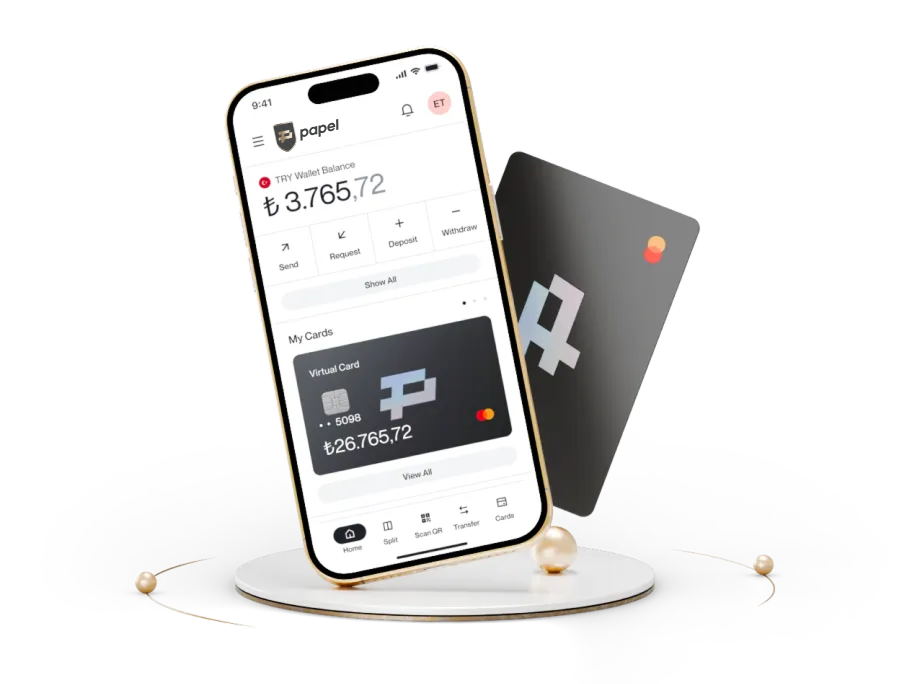Why Is Digital Transformation Important in B2B Payments?
As traditional payment methods are being replaced by digital solutions, choosing the most suitable payment system has become critical for businesses. So, what are B2B (business-to-business) payments, and which payment methods are the most advantageous for companies? Papel Blog explains the benefits of digitalization in B2B payment processes and the most suitable solutions for your business.
What is a B2B payment?
Financial transactions in exchange for goods or services between two or more businesses are called B2B (business-to-business) payments. B2B payments cover the money transfers that companies make for the products or services they provide to each other. In recent years, B2B payments, representing financial transactions in business-to-business relationships, have become faster and more efficient, especially with the increase in digital B2B payment platforms. Digital solutions that simplify payment transactions minimize manual processing, reduce the margin of error in transactions, and provide advantages to businesses with their low cost. Let’s examine how B2B payment transactions were in the past and how they have evolved today. We also present the solutions your business needs — join Papel, which offers big solutions for big businesses, and enjoy the benefits.
Traditional B2B payment methods
Before the widespread use of digital technologies, commonly used traditional B2B payment methods were:
H3: Cash payments
Paying in cash for goods or services was quite common. Cash payments were among the most frequently used, especially in small businesses.
H3: Use of checks
Businesses use this method since payment dates can be postponed when paying by check. It was advantageous because it made managing cash flow easier for businesses.
Use of promissory notes (bills)
Written documents that promise payment at a specified date between parties are called promissory notes (bills). This method was commonly used in long-term business relationships.
Bank transfers and EFT
Electronic Fund Transfers (EFT) and bank transfers allowed businesses to transfer money directly via banks and were considered more secure than other methods. For this reason, businesses preferred them for their reliability.
Digital B2B payment systems
With advancing technology, digital B2B payment methods have become preferred to traditional methods because they offer faster and more secure financial solutions. The leading digital B2B payment methods that allow businesses to manage financial transactions more efficiently are:
Electronic fund transfers (EFT) and fast payment systems
This method enables businesses to transfer money via banks electronically, reduces manual processes, minimizes error risks, and provides convenience by increasing transaction speed.
Digital wallets and mobile payment systems
Digital wallets like Papel Wallet, Apple Pay, and Google Pay allow businesses to make payments through mobile devices, accelerating the payment process and increasing security.
H3: Virtual POS systems
Virtual POS systems enable businesses to make credit or debit card payments on online platforms, streamlining payment processes and offering flexibility to customers.
Payment links and QR code payments
Businesses can receive easy and fast payments by sending customers payment links or QR codes. These methods offer practical solutions, especially for remote transactions.
Automatic billing and subscription models
For customers receiving regular services, automatic billing and subscription models automate the payment process, regulate cash flow, and enhance customer satisfaction.
Advantages of digitalization in B2B payments
We can list the significant benefits of digitalization in B2B (business-to-business) payment processes as follows:
Increased efficiency and faster transactions
Digital payment systems that automate manual processes ensure efficient execution and accelerate business processes, reducing time loss.
Cost savings
Digitalization eliminates the costs of manual processes through methods like e-invoicing and reduces operational expenses, enabling businesses to save money.
Reduced error rate
Digital systems automate data entries, minimizing input errors and improving transaction accuracy.
Data analysis and insight generation
Digitalization simplifies collecting and analyzing large datasets, supporting businesses in making strategic decisions.
Reliability and flexibility
Digital transformation offers businesses reliable and flexible solutions, increasing customer satisfaction and providing a competitive advantage.
Environmentally friendly practices
Digital processes that reduce paper usage promote environmental responsibility.
Digital payment solutions for companies
Digital payment solutions that speed up financial services and increase operational efficiency modernize business processes, providing a competitive advantage and boosting customer satisfaction. The most preferred popular digital payment solutions by businesses are:
H3: Virtual POS systems
Virtual POS systems allow payments to be made and received online using credit or debit cards without physical POS devices. It is one of the most popular methods e-commerce sites prefer to perform secure and fast transactions.
Digital wallets and mobile payments
Mobile payment options via digital wallets such as Papel Wallet, which securely store user financial information and enable quick and easy payments in online shopping and mobile applications, are among the favorite methods.
Payment links and QR code payments
Payment links and QR code payment methods allow businesses to send payment links to customers via email or SMS or receive payments via QR codes — flexible and fast solutions.
Blockchain and cryptocurrency payments
Blockchain-based payment systems stand out as innovative solutions that aim to conduct financial transactions decentralized, securely, and transparently. Due to their decentralized nature, these new systems lower transaction costs by eliminating intermediaries and provide ease in international transactions.
E-Invoice and E-Collection systems
The e-invoice, an electronic version of the traditional paper invoice, is issued according to standards determined by the Revenue Administration (GİB), carrying the same legal status as a paper invoice. Using e-invoicing accelerates processes and increases operational efficiency while eliminating costs like paper and printing. Moreover, e-invoices can be easily archived and accessed when needed. Using e-invoices also contributes to environmental sustainability by reducing paper consumption.
E-Collection is a system that enables businesses to receive payments electronically from customers through online payment infrastructures. This system simplifies and speeds up collection processes. The e-collection system integrates with existing accounting and ERP systems, automates financial workflows, and allows customers to make payments quickly and securely online. It also supports various payment methods like credit cards, debit cards, and bank transfers/EFT, making it highly beneficial for businesses.
In short, businesses that integrate e-invoice and e-collection systems digitalize their invoicing and collection processes, reducing costs and increasing operational efficiency.

Security and compliance in digital B2B payments
Security and compliance in digital B2B (business-to-business) payments are critical for protecting financial transactions, reducing fraud risk, and ensuring legal compliance. Security is, of course, important. So, what security measures and compliance standards should be in place?
Security measures
Advanced encryption techniques:
Encrypting entered data during payments using SSL (Secure Socket Layer) or TLS (Transport Layer Security) protocols ensures that third parties cannot read the data, enabling secure payments.
Two-factor authentication (2FA):
The two-factor authentication system provides an additional layer of security during user login, preventing unauthorized access.
PCI DSS compliance:
The Payment Card Industry Data Security Standard (PCI DSS) is a global standard for protecting payment card information. Digital payment service providers must comply with these standards.
Compliance standards
Compliance with data protection regulations:
Businesses must comply with data protection laws to safeguard customer and business partner data.
Regular security updates:
Continuously updating systems protects against emerging threats and prevents security vulnerabilities, ensuring ongoing security layers.
Frequently Asked Questions
What is SSL (Secure Socket Layer)?
It is an old encryption protocol that ensures secure internet data transmission.
What is TLS (Transport Layer Security)?
The updated encryption protocol has replaced SSL to ensure secure communication over the internet.
What is PCI DSS? What is two-factor authentication?
These are international security standards established to protect payment card information. You can find more information on the PCI DSS homepage.
What is two-factor authentication (2FA)?
A security system requires two different methods of verification for system access: something you know (password) and something you have (phone, hardware token).
What is an ERP system?
ERP (Enterprise Resource Planning) is software and technology-supported systems that manage a company’s core business processes in an integrated and often real-time manner.
What is the GDPR law?
The General Data Protection Regulation, which regulates personal data protection in the European Union, came into force in 2018.
The information provided in this blog post is for general informational purposes only and does not constitute legal, financial, or investment advice. The content is prepared solely for informational purposes, and seeking professional advice for your specific circumstances is recommended. The statements in this article do not create any binding obligations or liabilities and solely reflect the author's opinions. All decisions and responsibilities are yours, and Papel Elektronik Para ve Ödeme Hizmetleri A.Ş. assumes no liability.

